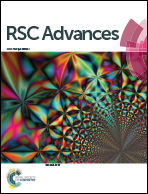Bioinspired ribbed hair arrays with robust superhydrophobicity fabricated by micro/nanosphere lithography and plasma etching†
Abstract
Inspired by the hierarchical seta arrays on the legs of a water strider, ribbed hair arrays have been fabricated on a polymethylmethacrylate (PMMA) substrate using polystyrene (PS) sphere colloidal lithography, followed by oxygen plasma reactive ion etching. Microscopic analyses of the as-synthesized samples demonstrate that each microhair is sculptured with elaborate nanogrooves, leading to a unique hierarchical micro/nanoscale feature and all the hairs are vertically aligned in a large area. Inspired by the novel hierarchical hair arrays, their static and dynamic wettability has been investigated. It is revealed that after fluorination, the hierarchical hair arrays can present robust superhydrophobicity, and the wettability can be tuned by altering the morphologies of the hair arrays. Based on these remarkable wetting properties, a simple aquatic device has been fabricated by covering both sides of a PMMA plate with the superhydrophobic hair arrays; the device shows both an excellent self-cleaning performance and a large loading capacity. It can carry a load that is 4.6 times heavier than its own weight. Experimental results and theoretical analysis demonstrate that the superhydrophobic properties of the upper and lower surfaces are responsible for the large loading capacity.


 Please wait while we load your content...
Please wait while we load your content...